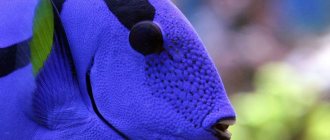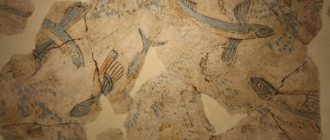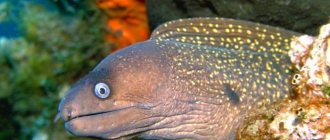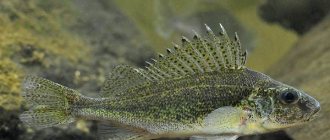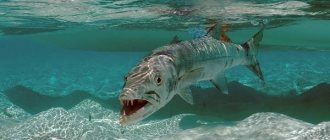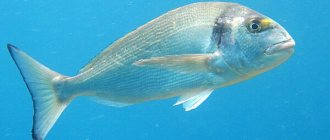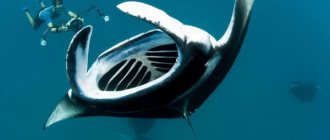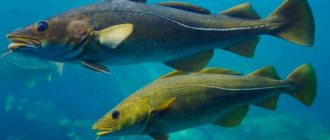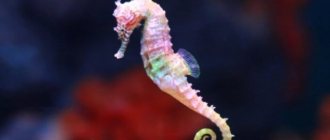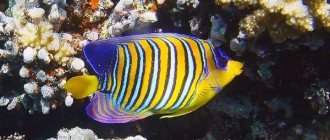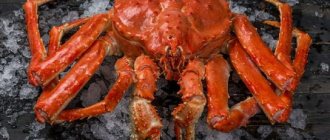Canned goby fish in marinade or tomato are familiar to everyone. Main courses are made from fresh and frozen. Dried fish soup is used to make very tasty fish soups. The cost of the product is budget.
What is the most in your diet?
- Meat 42%, 151 votes
151 votes 42%151 votes - 42% of all votes
- Fruits and vegetables 24%, 86 votes
86 votes 24%
86 votes - 24% of all votes
- Dairy products and eggs 17%, 60 votes
60 votes 17%
60 votes - 17% of all votes
- Fish 17%, 59 votes
59 votes 17%
59 votes - 17% of all votes
Total votes: 356
18.04.2020
- Meat 42%, 151 votes
151 votes 42%151 votes - 42% of all votes
- Fruits and vegetables 24%, 86 votes
86 votes 24%
86 votes - 24% of all votes
- Dairy products and eggs 17%, 60 votes
60 votes 17%
60 votes - 17% of all votes
- Fish 17%, 59 votes
59 votes 17%
59 votes - 17% of all votes
Total votes: 356
18.04.2020
×
You or from your IP have already voted.
Description and features
The main morphological feature that unites gobies is the sucker. Located on the ventral part of the body. Formed as a result of fusion of ventral fins. Serves to adhere fish to stones, corals, and bottom substrate. Keeps fish in the parking area even with significant current.
Gobies are small fish. But there are types of decent sizes. A large bull -whip grows up to 30-35 cm. Some record holders reach 0.5 meters. The smallest species is the dwarf goby Trimmatom nanus. It can be considered one of the smallest fish in the world. It does not exceed 1 cm.
This goby lives in the western Pacific and reef lagoons of the Indian Ocean. At a depth of 5 to 30 meters. Until 2004, it was considered the smallest vertebrate animal. Recent discoveries by biologists have moved it to third place.
An interesting feature of the goby is that the female can degenerate into a male
In second place was the coral fish Schindleria brevipinguis. The 7.9mm long carp, endemic to Indonesia, claims first place on this list. Its name: Paedocypris progenetica.
Despite the variation in size, the proportions of all bulls are similar. The head of the fish is large, slightly flattened above and below. A thick-lipped mouth spans the entire width of the head, above which there are large eyes. The first half of the body is cylindrical. The ventral part is slightly flattened.
Fish have two dorsal (dorsal) fins. The first one has hard rays, the second one has soft ones. The pectoral fins are powerful. Ventral (abdominal) forms a sucker. One anal fin. The tail ends in a rounded fin without blades.
Proportions and general anatomy of the body do not provide complete information about what a goby fish looks like. The difference in color between individual species can be significant. So much so that it is difficult to believe that the fish belong to the same family. This is especially true for tropical species.
Conditions of detention
Gobies are quite unpretentious, but they can be recommended for a “mature” aquarium. An important condition is a sufficient amount of sea sand at the bottom and an abundance of live stones with all kinds of crustaceans and worms, as an additional source of food for these fish.
The size of the gobies allows them to be planted in small aquariums (from 60 liters), and even in nano-aquariums (for example, Okinawan Gobiodon).
Suitable water parameters for gobies: temperature +24..+27 degrees, pH 8.1-8.4, salinity 1.020-1.025.
Valenciennea longfinned goby Valenciennea longipinnis
Kinds
All types of fish are classified in the directory “Fishes of the World”. A fifth edition was published in 2016, edited by Joseph S. Nelson. Systemic relationships in the goby family have been significantly changed. Of all the abundance of species, gobies inhabiting the Ponto-Caspian region can be distinguished. Some of them are commercial species.
- Round goby.
Medium sized bull. Males up to 15 cm, females up to 20 cm. One of the most important species in the Azov Sea from the point of view of commercial fishing. Males often die after the first spawning, at the age of two. Females can spawn several times and live up to five years.
It tolerates salty and fresh water well, so it is found not only in the Black, Azov and Caspian seas. It can rise along the rivers flowing into them up to the central regions of Russia. In this case, it manifests itself as a river goby .
- Sandpiper Goby.
The usual length of this fish is 12 cm. The largest specimens reach 20 cm. Just like the round fish adapted to fresh water. From the Black Sea it spread along the rivers of Ukraine, Belarus and Russia. , rotan and goby fish are found simultaneously . Due to their similar body shape, they are often confused. But fish are distant relatives, coming from different families.
- Shirman bull.
Inhabits the Black Sea estuaries, the Dniester, the lower reaches of the Danube, and the Sea of Azov. It spawns, like other gobies, in the spring. The female lays several thousand eggs. Incubation lasts two weeks. Hatched fry up to 7 mm long. After birth, they lie down on the bottom. After a couple of days, they begin to lead the active life of a predator. They devour all living things that are suitable in size. Mostly plankton. Related species are eaten as food, for example, round gobies.
- March goby.
Resident of the Azov and Black Seas. Tolerates water of varying degrees of salinity, including fresh water. Enters rivers. Quite large fish. Up to 35 cm in length and up to 600 g in weight. Predatory. Morals are appropriate: any living creature found at the bottom is eaten. In March, amateur fishermen on the Sea of Azov catch this species more often than other gobies. Hence the name - March.
Along with commercial species, gobies are of interest - residents of marine and reef aquariums. Valenciennea is well known to aquarists. This is goby . Named after the famous French zoologist Achille Valenciennes, who lived in the 19th century. This is a whole family. It includes about 20 species. The most popular four.
- Golden-headed goby.
- Red-spotted goby.
- Pearl valencienne goby.
- Two-banded goby.
These fish constantly dig in the ground. They are called “burrowing gobies.” They have a simple nutrition strategy. Gobies grab soil with their mouths. Using transverse filter plates located in the mouth, the bottom substrate is sifted. Sand, pebbles, and debris are thrown out through the gills. Anything with a hint of nutritional value is eaten. In addition to their active character, aquarists appreciate their elegant appearance in bulls.
The Rainford goby, or Amblygobius rainfordi, is particularly attractive. This small beautiful fish, the goby in the photo is extremely impressive. It went on general sale only in 1990. As reef aquariums began to grow in popularity. In nature, it does not gather in groups or flocks, prefers loneliness. In an aquarium, it may not get along with its own kind.
The most amazing thing about the Dracula bull is its name. Why Stonogobiops dracula, a resident of the Seychelles and Maldives, received this name is difficult to say. A small striped fish coexists in the same hole with a shrimp. Probably, the simultaneous appearance of a goby and a shrimp from a hole made a strong impression on its discoverer.
Popular varieties
Two large groups can be distinguished:
- Marine.
- Brackish water.
The main representative and target of fishing enthusiasts is the green goby. The second type originally lived in the Black Sea waters and Azov. Over time, it acquired the ability to settle in fresh shallow waters of rivers and shallow estuaries.
Fishermen give popular names to this popular species: sandpiper, gorlac, round timber, bubyr, tsutsik. The largest is the martovik, or whip goby, reaching a weight of half a kilogram and an average size of 35 cm.
Lifestyle and habitat
Gobies are found throughout the world. They prefer the tropics and temperate climates. Adapted to salty, lightly salted and fresh water. The freshwater goby lives in rivers and cave reservoirs. mangrove swamps, at the bottom in the coastal zone of the seas. Some species live in the lower reaches of rivers, where the water has variable salinity. 35% of the total number of gobies are inhabitants of coral reefs.
There are species of fish that organize their lives in a very remarkable way. These are shrimp gobies. They entered into symbiosis with other marine inhabitants. They benefit from coexistence with the snapper shrimp, which also did not go unnoticed.
She builds a hole in which she can hide herself and has enough space to accommodate one or two bulls. The goby, using its excellent vision, warns the shrimp of danger. She, in turn, maintains the common house in good condition. Gobies not only live in the hole themselves, but also breed offspring in it.
Another example of symbiosis is the life structure of neon gobies. They work as orderlies: they clean the body, gills and mouths of large, including predatory fish. The place where neon gobies live turns into a parasite cleaning station. The rule that a large predatory fish eats a small one does not work in the sanitary zone.
Application not only in cooking
Gobies are very popular in marine aquarium keeping. They are loved for their bright appearance and unfussy character. These are ideal inhabitants of reef aquariums. If provided with the right environment and feeding, they get along with most other non-aggressive fish species.
These fish require a large bottom area covered with a thick layer of sand. There should be a minimum of large decorative fragments in the aquarium. Gobies like to spend their time searching for food, swallowing sand and spitting it out. Therefore, it must be of high quality. If there is not enough space in the artificial reservoir, this factor will provoke conflicts between individuals. As for breeding in captivity, usually the matter does not move beyond spawning.
Nutrition
Gobies are carnivorous inhabitants of seas and rivers. They receive the main share of their food allowance by examining the sea or river bottom. In bottom waters they are saturated with zooplankton. The diet includes the larvae of any fish and insects, crustaceans such as amphipods, and gastropods.
Despite the apparent slowness, the fish of the goby family successfully attacks smaller relatives. In addition, it eats eggs and fry of other fish. But the appetite of gobies does not lead to a decrease in the populations of fish adjacent to them.
Brachygobius, or bee gobies
These bulls got their name due to their characteristic striped black and yellow coloring. During the spawning season, the males' stripes turn red or orange. The length of the bee gobies does not exceed 4.5 centimeters.
Under natural conditions, these fish are found in mangrove swamps and rivers of Asia. These fish are slow, have a peaceful nature, but they are characterized by territorial behavior, so if they are kept in an aquarium, then there should be plenty of hiding places.
Goldenstriped gobies like to hide, but in general they have a peaceful nature.
Reproduction and lifespan
Tropical goby fish species do not adhere to strict seasonality when breeding. In temperate regions, everything is more certain. The mating season begins in the spring and can last throughout the summer.
The male prepares a shelter. This could be a hole, a sink cleared of debris, a gap between stones. The walls and ceiling of the nest should be smooth. The male is responsible for this. After the preparatory work, mating occurs. Before spawning, the female settles into the nest: leaves it and settles down again.
Spawning occurs during the day. The mother carefully glues the eggs that appear in an even layer to the walls and ceiling of the shelter, then leaves it. The male takes over. Its task is to create water circulation with its fins, thereby providing the eggs with oxygen. In addition, he protects future bulls.
It takes at least a week for the eggs to mature. The emerging fry begin to lead an independent life. Bottom plankton becomes their food, and algae, stones, and corals become their protection.
Young bulls, if successful, at the age of two years can breed their own offspring. The lifespan of these fish ranges from 2-5 years. Some species, especially males, only have one chance to produce offspring. After the first spawning they die.
Scientists have discovered an amazing ability in a number of tropical species of gobies. They can change gender. This metamorphosis is typical for fish of the species Coryphopterus personatus. Females can regenerate into males. There is speculation about the possibility of males turning into females. Gobies of the genus Paragobiodon are suspected of this.
Composition and benefits
In addition to outstanding taste characteristics, such fish can please you with the presence of easily digestible proteins. Also, the content of each individual will delight you with a rich composition of microelements such as:
- molybdenum;
- calcium;
- chromium;
- gland;
- fluorine;
- zinc
Particularly significant reserves of nutrients are retained in dried versions, which are prepared in accordance with all food safety standards.
Their meat loses about 80% of water, but at the same time leaves a huge amount of vitamins D, , , , .
There are sufficient quantities of polyunsaturated acids in Omega-3 and Omega-6 formats. The human body is not able to generate them on its own, so we have to extract them from incoming food.
With a cumulative effect, acids inhibit the aging process and are a reliable protection against the possible development of cardiovascular diseases. If you consume goodies on a regular basis in the dosages required for the body, then over time you will be able to achieve significant success in this field.
In particular, bulls are useful for the prevention of the following diseases:
- stabilization of the intestines;
- prevention of atherosclerosis due to the presence of iodine;
- reduction of bad cholesterol levels;
- reducing the risk of depression;
- prevention of senile dementia.
Moreover, to obtain all of the above, it is absolutely not necessary to eat exclusively steamed bulls in their pure form. To simplify the task for adherents of a healthy lifestyle and all those who adhere to the basics of dietary nutrition, experts have developed a special algorithm. He tells you what other ingredients predatory sea and river fish will go well with.
Vegetables like tomatoes, onions, beans and bell peppers took first place. Among the fruits, citrus fruits stand out, and among the spices, the best pair would be cloves, bay leaves and rosemary with black pepper. Goby goes well with parsley, basil and dill.
Goby fishing
Few species of these fish are commercial targets. But goby populations indirectly affect commercial fishing results. Goby is a fish that is included in the diet of other marine life: cod, sea bass, flounder.
Catching gobies is one of the traditional activities of the Black Sea and Azov amateur fishermen. It is also popular among fishermen living in the Caspian Sea. The tackle is simple. Usually this is a float rod or donka.
The main thing is that the bait lies freely on the ground. Pieces of fish flesh, worms, and maggots can be used as bait. Successful fishing, especially at first, is only possible after consulting with a local expert.
Industrial fishing is carried out using drag nets and fixed nets. The usual method for catching predatory, bottom-dwelling fish is hook tackle such as a seine. The volume of industrial production of goby in Russia is insignificant and is not included in the statistical indicators of Rosrybolovstvo.
Tropical species have taken part in the fishing business in a different way: they have become regulars in home aquariums. So popular that they are caught, raised and sold on an industrial scale.
Notes[ | ]
- Family Gobiidae
(English) in the World Register of Marine Species. (Accessed: May 13, 2019). - Nelson D.S.
Fishes of the world fauna / Transl. 4th rev. English ed. N. G. Bogutskaya, scientific. editors A. M. Nasek, A. S. Gerd. - M.: Book House "LIBROKOM", 2009. - P. 578. - ISBN 978-5-397-00675-0. - ↑ 1 2 Nelson JS, Grande TC, Wilson MVH
Fishes of the World. — 5th ed. - Hoboken: John Wiley & Sons, 2016. - P. 331-332. — 752 p. — ISBN 978-1-118-34233-6. - doi:10.1002/9781119174844. - Vasilyeva E. D.
Fishes of the Black Sea. Key to marine, brackish-water, euryhaline and anadromous species with color illustrations collected by S. V. Bogorodsky. - M.: VNIRO, 2007. - P. 140. - 238 p. — 200 copies. — ISBN 978-5-85382-347-1. - Huang S.-P., Zeehan J. & Chen I.S. (2014). A New Genus of Hemigobius
Generic Group Goby Based on Morphological and Molecular Evidence, With Description of a New Species.
Archived from the original on February 25, 2014. Journal of Marine Science and Technology 21
(Suppl.) [2013]: 130–134. - A monument to the “Breadwinner Bull” (undefined)
. Korrespondent.net. Access date: March 15, 2022. - Bulls in tomato sauce // Commodity Dictionary / I. A. Pugachev (editor-in-chief). - M.: State Publishing House of Trade Literature, 1956. - T. I. - Stb. 702—703
Yellow clown goby or Okinawan goby
These gobies live in reefs in Indonesia and the Philippines. They are small in size - the body length does not exceed 2.5-3.5 centimeters. The coloring of these fish is bright canary.
Clown bulls are peaceful creatures. They have a timid disposition. They get along well with other fish, but they constantly fight with representatives of their own species for cover. Therefore, they must live in spacious aquariums, and each individual must have enough places to hide.
If you find an error, please select a piece of text and press Ctrl+Enter.
